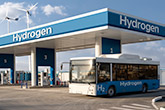CB&I and Shell demonstrate liquid hydrogen storage tank
Published by Ellie Brosnan,
Editorial Assistant
Global Hydrogen Review,
CB&I and a consortium including Shell International Exploration and Production, Inc. (Shell), a subsidiary of Shell plc, GenH2, and the University of Houston have announced the completion of an affordable, large scale liquid hydrogen (LH2) storage tank concept at NASA's Marshall Space Flight Centre (MSFC) in Huntsville, Alabama, US, that will enable international import and export applications.
“Our collaboration with this project team will help provide a path to low-cost, large scale liquid hydrogen storage,” said Mark Butts, President and CEO of CB&I. “We are proud to leverage our experience with cryogenic insulation and storage to advance solutions for the energy transition market.”
The project, which began in 2021 and is supported by the US Department of Energy (DOE), developed a novel, non-vacuum tank design concept for large scale (up to 100 000 m3) storage of LH2 that is anticipated to provide a substantial cost advantage over conventional vacuum insulated tanks. This concept is being demonstrated through the construction, start-up, and testing of a small scale LH2 demonstration tank at NASA MSFC.
“At Shell, we believe in the power of collaboration to advance technology and scale up solutions,” commented Theo Bodewes, General Manager, Hydrogen Technology. “With support from the DOE, this project demonstrates how experts from industry, academia, and government can solve complex technology challenges. This liquid hydrogen technology promises to be more competitive, reducing costs and accelerating large-scale storage commercialisation.”
The demonstration tank will significantly increase the MSFC hydrogen test facility's LH2 storage capacity and be used to characterise the behaviour of materials under cryogenic conditions, mimicking normal fill and empty cycles and testing non-vacuum insulation materials. In addition to an estimated six-month test period included in the project scope, a Space Act Agreement among the partner organisations provides for MSFC's use of the tank over a five-year period, during which CB&I and Shell will continue to test new insulation technologies under non-vacuum conditions.
“We take pride in participating in this industry collaboration to advance commercial liquid hydrogen storage applications,” stated James Fesmire, GenH2 Chief Architect. “This initiative has allowed us to develop testing capabilities for thermal insulation systems and produce essential data for unlocking the global potential of liquid hydrogen.”
Dr. Ramanan Krishnamoorti, Vice President of Energy and Innovation at the University of Houston, added: “The ability to store liquid hydrogen at scale using a non-vacuum design is a pivotal advancement and opens the door to a more flexible, affordable global hydrogen trade infrastructure. Solutions such as this will be key to advancing our energy economy.”
CB&I built the first LH2 sphere for NASA and NASA contractors in the 1960s, with a capacity of 170 m3, and has expanded that threshold over the last 60 years by almost 30-fold to 5000 m3 with a tank completed in 2022 at Kennedy Space Centre for the Artemis programme. CB&I has completed over 130 LH2 storage vessels since the 1960s.
The company and NASA have had a partnership of more than 60 years, with CB&I contributing to many NASA projects, including several supporting the Apollo and Gemini space missions.
Read the article online at: https://www.globalhydrogenreview.com/hydrogen/16042025/cbi-and-shell-demonstrate-liquid-hydrogen-storage-tank/
You might also like
REWE Nord saves 48 t of CO2
REWE Nord has received certification that it has saved 48 t of carbon dioxide with hydrogen-powered trucks from hylane.

